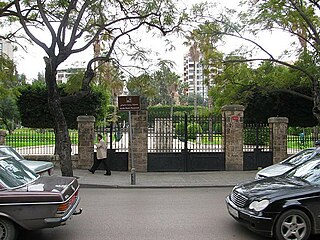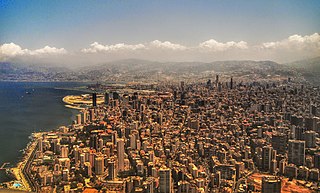
Lebanon, officially the Republic of Lebanon, is a country in the Levant region of West Asia. It is bordered by Syria to the north and east, by Israel to the south, and by the Mediterranean Sea to the west; Cyprus lies a short distance away from the country's coastline. Lebanon's location at the crossroads of the Mediterranean Basin and the Arabian hinterlands has contributed to the country's rich history and shaped a unique cultural identity shaped by religious diversity. Lebanon has a population of more than five million people and covers an area of 10,452 square kilometres (4,036 sq mi). Lebanon's capital and largest city is Beirut, followed by Tripoli and Jounieh. While Arabic is the official language, French is also recognized in a formal capacity; Lebanese Arabic is the country's vernacular, though French and English play a relatively significant role in everyday life, with Modern Standard Arabic being limited to news and government matters.

Beirut is the capital and largest city of Lebanon. As of 2014, Greater Beirut has a population of 2.5 million, which makes it the third-largest city in the Levant region and the thirteenth-largest in the Arab world. The city is situated on a peninsula at the midpoint of Lebanon's Mediterranean coast. Beirut has been inhabited for more than 5,000 years, making it one of the oldest cities in the world.

The 1958 Lebanon crisis was a political crisis in Lebanon caused by political and religious tensions in the country that included a United States military intervention. The intervention lasted for around three months until President Camille Chamoun, who had requested the assistance, completed his term as president of Lebanon. American and Lebanese government forces successfully occupied the Port of Beirut and Beirut International Airport. With the crisis over, the United States withdrew.
Solidarité Française was a French far-right league founded in 1933 by the perfume manufacturer François Coty (1874-1934) as the "Parti national corporatif républicain".

The State of Greater Lebanon, informally known as French Lebanon, was a state declared on 1 September 1920, which became the Lebanese Republic in May 1926, and is the predecessor of modern Lebanon.

The Syria–Lebanon campaign, also known as Operation Exporter, was the invasion of Syria and Lebanon in June and July 1941 by British Empire forces, during the Second World War.

Saint Joseph University of Beirut is a private Roman Catholic research university located in Beirut, Lebanon, which was founded in 1875 by French Jesuit missionaries and subsidized by the Government of France during the time when Lebanon was under Ottoman rule. It is widely recognized as one of the leading and most prestigious academic institutions in Lebanon and Middle East. USJ's roster of graduates includes seven of independent Lebanon's thirteen Presidents, a Speaker of the Parliament of Lebanon, two Presidents of the Council of Ministers of Lebanon, Governors of the Banque du Liban, hundreds of legislators and ministers, numerous judges, and high-ranking civil servants, among them Commanders of the Lebanese Armed Forces and executives of the Internal Security Forces. As the oldest and foremost French university in Lebanon, it not only promotes Lebanese culture but also upholds a policy of equal admission opportunity without consideration of ethno-religious affiliations. Furthermore, it advocates trilingual education, offering instruction in Arabic, French, and English. Additionally, it is known in Lebanon and the Middle East for its prominent university hospital, the Hôtel-Dieu de France, and for its prestigious and historical Faculty of Law, modern Lebanon's oldest law school and the first law school in Lebanon since the ancient Roman law school of Berytus.

Rue Gouraud is a mixed residential and commercial street in Gemmayzeh, a neighborhood in the Rmeil district of Beirut in Lebanon. It is named after French General Henri Gouraud. Gemmayze, and Rue Gouraud specifically, and competes with the trendy village-type neighborhood of Badaro, as one of Beirut's bohemian quarters. the district is full of narrow streets and historic buildings from the French era. The neighborhood is well known today for its trendy bars and pubs, cafes, restaurants and lounges, most of which are directly located on Rue Gouraud.
Rue Gouraud is known especially for its culinary scene that is popular with Beirut's fashionistas. The street runs east of Beirut Central District and the Saifi Village, extending from Avenue Georges Haddad and reaching the Corniche du Fleuve. In 2004, Travel + Leisure magazine called the street "SoHo by the Sea," due to its colorful and chic cafés amid 1950's apartment buildings and hole-in-the-wall shops.
Rue Clemenceau is a commercial and residential street in Beirut, Lebanon. The street was named in honor of Georges Clemenceau who accepted the post of premier of France in 1917 during World War I. The neighborhood straddling Clemenceau Street was prior to the war one of the most cosmopolitan areas of the city and home to Christians, Muslims, Druze and Jews.

The René Moawad Garden known by the public as the Sanayeh Garden is located in the Sanayeh district of Beirut, Lebanon. The garden is one of the oldest public open-air spaces in the capital. Khalil Pasha (1864–1923), commander of the Turkish Sixth Army during World War I ordered the creation of the garden in 1907.

Bliss Street, or Rue Bliss, is one of the principal streets of the Hamra area, which is within the Ras Beirut District of Beirut in Lebanon. The street, which is parallel to Hamra Street, runs east-west, connecting with Rue Clémenceau on the east and ending at Avenue General Charles de Gaulle that runs along the coast of the Mediterranean.

Hamra Street or Rue Hamra is one of the main streets of the city of Beirut, Lebanon, and one of the main economic and diplomatic hubs of Beirut. It is located in the neighborhood of the same name, Hamra. Its technical name is Rue 31. Due to the numerous sidewalk cafes and theatres, Hamra Street was the centre of intellectual activity in Beirut during the 1960s and 1970s. Before 1975, Hamra Street and the surrounding district was known as Beirut's trendiest, though in the post-war period it has arguably been eclipsed by Rue Monot in Ashrafieh, Rue Gouraud in Gemmayzeh, Rue Verdun, and downtown area. In the mid 1990s, the Municipality of Beirut gave a facelift to the street to reattract tourists all year round. Hamra Street was known as Beirut's Champs Elysées, as it was frequented by tourists all year round.

France–Lebanon relations are the international relations between France and Lebanon. France, the previous administrative power, enjoys friendly relations with Lebanon and has often provided support to the Lebanese. The French language is widely spoken fluently throughout Lebanon and is taught as well as used as a medium of education in many Lebanese schools. Both nations are members of the Francophonie.

Ras Beirut is an upscale residential neighborhood in Beirut, Lebanon. It has a mixed population of Christians, Muslims and Druze individuals. Ras Beirut is associated with intersect interactions and relations in every-day life.
Rue Huvelin, is a street located east of Beirut Central District in the neighborhood of Achrafieh. The street is named after Paul Huvelin, a French legal historian who founded the law school of the Université Saint-Joseph in Beirut in 1913. The street was home to the campus of the Petit Collège and Grand Collège of Collège Notre Dame de Jamhour before relocating in the 1950s to the mountain town of Jamhour, Lebanon.
Rue de Phénicie or Phoenicia Street is a street in Beirut, Lebanon. The street runs north–south from the Mediterranean uphill to where Rue John Kennedy meets Rue Omar Daouk, intersecting along the way Rue Ibn Sina, Rue London, and Rue Rustom Pacha.

The architecture of Lebanon embodies the historical, cultural and religious influences that have shaped Lebanon's built environment. It has been influenced by the Phoenicians, Romans, Byzantines, Umayyads, Crusaders, Mamluks, Ottomans and French. Additionally, Lebanon is home to many examples of modern and contemporary architecture. Architecturally notable structures in Lebanon include ancient thermae and temples, castles, churches, mosques, hotels, museums, government buildings, souks, residences and towers.

The East Beirut canton, also known as Kfarchima - Madfoun or Marounistan, was a Christian-dominated geopolitical region that existed in Lebanon from 1976 until its gradual erosion following the Taif Agreement and the end of the country's civil war. It was one of the wartime state-like territories, controlled by the Lebanese Forces (LF) militia, and was separated in the Lebanese capital, Beirut, from Muslim majority West Beirut by the Green Line, extending outside the capital northward to include the region of Keserwan up till the city of Byblos on the western coast and the northern part of Mount Lebanon to the northeast. It bordered the Zgharta region to the north, which was controlled by a rival Christian militia, the Marada Brigade which controlled a canton known as the Northern canton.

The earliest settlement of Beirut was on an island in the Beirut River, but the channel that separated it from the banks silted up and the island ceased to be. Excavations in the downtown area have unearthed layers of Phoenician, Hellenistic, Roman, Byzantine, Arab, Crusader, and Ottoman remains.
Edvick Jureidini Shayboub, born 1 February 1918, was a Lebanese journalist, news presenter, feminist, activist, and educator. She died in 2002.















